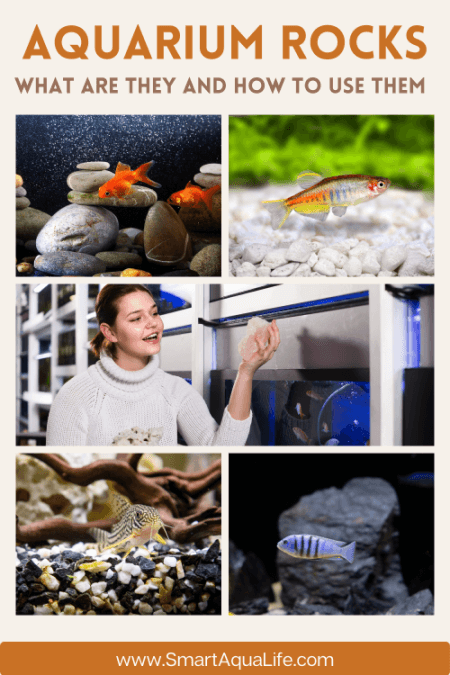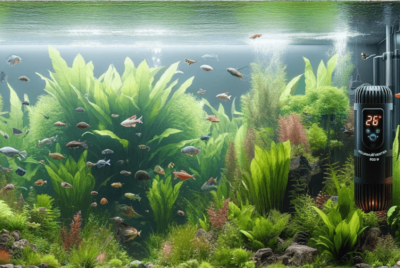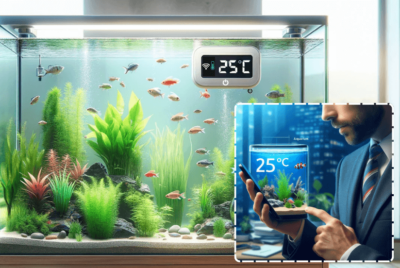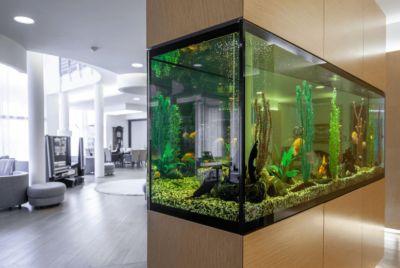Aquarium Rocks: What Are They and How to Use Them
Introduction to Aquarium Rocks
Ever found yourself meandering through the colorful aisles of an aquarium store, captivated by the myriad of shapes and colors of aquarium rocks? These pieces are not merely for decoration; they are crucial for creating a natural, inviting habitat for your fish. But what are aquarium rocks exactly, and how should you use them to their full potential? Let’s take a closer look and uncover the secrets of utilizing aquarium rocks to turn your fish tank into a mesmerizing underwater oasis.
Aquarium rocks serve as miniatures of the vast, varied habitats our aquatic friends call home, offering them a piece of the wild in the comfort of your home. Whether you’re an experienced aquarist or a newcomer, knowing how to select and use these rocks is essential. They play a significant role in your aquarium’s ecosystem, from enhancing its beauty to influencing water chemistry. Join me as we dive into the fascinating world of aquarium rocks, exploring their types, benefits, and how to deploy them in your aquarium for the utmost visual appeal and ecological balance.
Types of Aquarium Rocks
Diving into the fascinating world of aquariums, one can’t help but marvel at the variety of rocks available to enhance the beauty and ecological balance of your aquatic setup. Each type of aquarium rock, with its unique texture and composition, plays a pivotal role in creating an environment that’s not only visually appealing but also beneficial for the inhabitants. Let’s delve into the details of the different types of rocks you can choose from and how they can transform your aquarium.
Igneous Rocks:
These are the superheroes of the aquarium world, formed from the cooling of molten lava. With their hard, stable nature, igneous rocks such as basalt and lava rock are perfect for any aquarium. They’re not just rocks; they’re natural art pieces that offer a dramatic, eye-catching look. Their porous nature is excellent for beneficial bacteria growth, which is essential for a healthy aquarium ecosystem. If you’re aiming for a setup that mimics the rugged, volcanic underwater landscapes, igneous rocks are your go-to choice.
Sedimentary Rocks:
Imagine the history of the earth compressed into layers upon layers of sediment, and you have sedimentary rocks. These rocks, including the ever-popular sandstone and limestone, are formed over millions of years through the accumulation of sediment. They bring softer colors and textures to your aquarium, creating a serene and natural ambiance. Sandstone, with its warm hues, and limestone, known for its lighter tones, can create stunning backdrops that highlight the colors of your fish and plants. Plus, their smoother edges make them safe for all types of fish, ensuring your aquatic friends can explore without harm.
Metamorphic Rocks:
The alchemists of the rock world, metamorphic rocks transform heat and pressure to become the sleek, polished gems of your aquarium. Slate and marble are prime examples, offering an elegant and sophisticated touch to your aquatic environment. Slate’s layered appearance and durability make it ideal for creating stable structures and caves that fish love to explore. Marble, with its unique patterns and ability to subtly alter water hardness, can add a touch of luxury to your setup. However, it’s wise to use marble judiciously, especially in tanks with species sensitive to changes in water chemistry.
Incorporating these different types of rocks into your aquarium not only boosts its aesthetic appeal but also contributes to a more natural and enriching habitat for your fish. Whether you’re aiming for the dramatic flair of igneous rocks, the soft natural beauty of sedimentary rocks, or the elegant sophistication of metamorphic rocks, there’s a world of possibilities waiting to be explored. Remember, the key to a successful aquarium is not just in the beauty of its components but in creating a balanced, healthy environment where your aquatic friends can thrive. So, take your time, do your research, and choose the rocks that best suit your vision and the needs of your aquarium’s inhabitants.
Why Use Aquarium Rocks?

Aquarium rocks serve multiple purposes in both freshwater and marine aquariums, far beyond just enhancing the tank’s aesthetic appeal. Here are some key reasons why using aquarium rocks is beneficial:
1. Natural Habitat Simulation:
Rocks help in recreating a natural environment similar to the habitats where fish and other aquatic creatures originate. This is crucial for the well-being and natural behavior of the tank inhabitants, as it provides them with hiding spots, breeding grounds, and territories, mimicking their environment in the wild.
2. Biological Filtration:
Porous rocks such as lava rocks can serve as an excellent medium for beneficial bacteria to colonize. These bacteria are vital for the nitrogen cycle, converting harmful ammonia and nitrite into less harmful nitrates, thereby maintaining water quality and the health of the aquarium ecosystem.
3. Water Chemistry Regulation:
Certain types of rocks can alter the chemistry of the water in your tank. For example, limestone can increase the pH and hardness of the water, which is beneficial for species that thrive in alkaline conditions. It’s important to choose rocks that are compatible with the specific needs of your aquarium’s inhabitants.
4. Aesthetic Value:
Rocks add visual interest and depth to your aquarium, making it more engaging and pleasing to the eye. They can be used to create stunning landscapes, from rugged mountains capes to serene riverbeds, enhancing the overall beauty of the aquarium.
5. Behavioral Enrichment:
The structure provided by rocks can encourage natural behaviors in fish and other aquatic animals. For example, cichlids often rearrange rocks to build nests, while other species may use them as shelter or for foraging. This enrichment is essential for the psychological well-being of aquarium inhabitants.
Incorporating rocks into your aquarium setup is a great way to create a healthier, more attractive, and stimulating environment for your aquatic pets. It’s essential, however, to research and select the right types of rocks that will suit the specific needs of your tank’s ecosystem, ensuring they are safe and beneficial for your aquatic friends.
How to Choose the Right Aquarium Rocks
Embarking on the journey of setting up or refurbishing an aquarium is an exciting adventure, filled with decisions that shape the underwater world you’re aiming to create. Among these decisions, choosing the right rocks is not just a matter of aesthetics but a crucial aspect of ensuring a healthy and visually appealing environment for your aquatic friends. Let’s take a closer look at how to select the perfect rocks for your aquarium, keeping both the beauty of your setup and the well-being of your fish in mind.
Consider the Type of Fish
The first step in selecting the right aquarium rocks is to consider the type of fish you have. Each species has evolved in unique environments, with specific conditions that contribute to their health and happiness. By researching the natural habitats of your fish, you can choose rocks that enhance your tank’s visual appeal. These rocks also recreate a piece of their native ecosystem. For species that thrive in gentle streams, selecting smooth river rocks is ideal. Conversely, for fish accustomed to life among underwater lava formations, opting for rugged, volcanic rocks is suitable. Mimicking your fish’s natural environment not only makes your aquarium more aesthetically pleasing but also promotes natural behaviors, reduces stress, and supports the overall health of your aquatic pets.
Check the Rocks for Safety
Once you’ve pinpointed the types of rocks that best suit your aquarium’s theme and inhabitants, the next step is to ensure these rocks are safe. The underwater environment is delicate, and the wrong type of rock can do more harm than good. Here are key safety considerations:
- Avoid Sharp Edges: Fish, especially active swimmers or species that like to explore, can easily injure themselves on sharp edges. Inspect potential rocks for jagged points, and opt for those with smoother surfaces. If a rock is perfect in every other way but has some sharp edges, you can gently sand these down to make it safe for your tank.
- Chemical-Free Choices: The balance of your aquarium’s water can be easily upset by rocks that leach harmful chemicals or significantly alter pH levels. Conducting a vinegar test is a simple way to check for rocks that may release calcium carbonate, which can raise the pH of your water. Place a few drops of vinegar on the rock; if it fizzes, it’s likely to affect your water chemistry and may not be suitable for all types of fish, particularly those preferring acidic environments.
- Consider Size and Stability: The size and weight of the rocks you choose should be appropriate for your aquarium’s size and structural integrity. Large, heavy rocks can be stunning focal points but ensure your aquarium’s base can support them. Additionally, think about the stability of your rock arrangements. Securely placing rocks to prevent accidental toppling is essential for the safety of your fish.
Preparing Aquarium Rocks for Your Aquarium
Preparing your aquarium rocks before introducing them to your tank is crucial to ensure they do not bring any harmful bacteria, parasites, or unwanted chemicals into your aquatic environment. A thorough cleaning process can make all the difference in maintaining the health and balance of your aquarium. Here’s a step-by-step guide on how to properly clean aquarium rocks, ensuring they are safe and ready to enhance the beauty of your underwater world.
Cleaning Process
- Rinse with Plain Water: Begin by rinsing the rocks with plain, cold water to remove loose dirt and debris. Avoid using hot water, as it can cause certain rocks to crack due to the sudden temperature change. This initial rinse is an essential first step to get rid of the easy-to-remove surface dirt.
- Brush the Rocks: Use a stiff brush (a new, never-used-before toothbrush works well) to scrub the surface of each rock. This helps remove any algae, dirt, or organic matter stuck to the rocks. For tougher algae or stains, soaking the rocks in water for a few hours before scrubbing can help loosen the material.
- Boil or Soak in Hot Water: For rocks small enough to fit in a pot, boiling them for about 10-20 minutes can kill off most bacteria and algae. If boiling is not practical, soaking the rocks in very hot water (just off the boil) can be an effective alternative. However, be cautious with this step—certain rocks, especially those with cracks or fissures, can explode or break when subjected to high temperatures. If in doubt, skip this step.
- Vinegar Soak for Calcium Deposit: If your rocks have hard water stains or calcium deposits, soaking them in a solution of white vinegar and water (1 part vinegar to 3 parts water) can help dissolve these deposits. After soaking for several hours, scrub the rocks again with the brush. Rinse thoroughly after this step to ensure all vinegar is washed away, as any residue can affect your tank’s pH balance.
- Bleach Soak for Stubborn Contaminant: For rocks that need a deeper clean, a bleach soak can be effective. Mix a solution of 1 part bleach to 10 parts water and soak the rocks for about 15-30 minutes. This step is excellent for killing stubborn algae and sanitizing the rocks. After soaking, it’s crucial to rinse the rocks very thoroughly in running water. Then, soak the rocks in fresh water with a dechlorinator added, or simply leave them to air dry for several days to ensure all bleach has dissipated. Exercise caution with this method and ensure the rocks are completely bleach-free before adding them to your aquarium.
- Final Rinse and Dry: After cleaning, give the rocks one final rinse in plain water to remove any remaining cleaning agents or loosened debris. Allow the rocks to air dry completely. This not only ensures they are clean but also prevents any potential shock from temperature changes when adding them to your aquarium.
- Inspect and Place in the Aquarium: Before placing the rocks in your tank, inspect them one last time for any missed spots or residue from the cleaning process. Once satisfied, you can carefully place the rocks in your aquarium, creating the desired layout and providing a safe, enriching environment for your aquatic life.
Cleaning your aquarium rocks thoroughly before introducing them into your tank is essential. This prevents the introduction of harmful elements into your aquatic ecosystem. By following these steps, you ensure your rocks are visually appealing. They also contribute to a healthy and stable environment for your fish and plants.
Testing for Suitability
The vinegar test quickly identifies if a rock contains calcium carbonate, affecting aquarium water pH by making it more alkaline. Rinse the rock, apply a few drops of vinegar, and watch for fizzing, which indicates calcium carbonate presence. No reaction means the rock is safe and won’t alter pH levels.
Based on the test results, choose rocks that match your aquarium’s needs. Avoid fizzing rocks for species requiring neutral or acidic environments, and consider them for alkaline-preferred species. Rinse the rocks post-test to remove vinegar, ensuring they’re ready for your aquarium. This method aids in selecting appropriate rocks, maintaining a balanced habitat for your aquatic life.
Setting Up Rocks in Your Aquarium

The arrangement of rocks in an aquarium enhances its visual appeal. It also significantly impacts the habitat’s functionality and the well-being of its inhabitants. Properly placed rocks provide essential hiding spots, encourage natural behaviors, and help in territory establishment for aquatic life. Additionally, they can influence water flow and filtration, ensuring efficient circulation and waste removal. Thus, a thoughtful rock setup not only beautifies the tank but also supports a healthy, dynamic environment for aquatic creatures.
Aquarium Rocks Placement Tips
When arranging rocks in your aquarium, aim for a layout that feels both natural and functional. Start by placing larger rocks first to establish the main structure and avoid shifting once the tank is filled. Consider the natural habitats of your fish when selecting rocks for your aquarium. Use these rocks to mimic their environments, creating caves, ledges, and hiding spots. To ensure stability, position the rocks directly on the tank’s bottom. This method, rather than placing them on the substrate, prevents digging fish from toppling the structures.
Create open swimming spaces by keeping the central area less cluttered. Finally, take the time to visualize your aquarium from various angles. This ensures the layout is visually appealing and offers ample space for your aquatic friends to thrive. This thoughtful approach enhances your tank’s aesthetic appeal. Additionally, it promotes a healthier and more engaging environment for its inhabitants. By doing so, you ensure they have a space that is both beautiful and conducive to their well-being.
Creating Natural-looking Structures
For a truly engaging aquarium, incorporating natural-looking structures like caves and ledges using rocks is key. This approach significantly enhances the habitat for your fish, mimicking the complexity of natural environments. These features provide essential hiding spots and exploration areas crucial for fish well-being. When building these structures, it’s important to focus on stability to prevent any harm to your fish. Carefully layer and secure the rocks, using aquarium-safe silicone if necessary, to ensure they remain in place.
Aim for a balanced design that offers ample space for your fish to swim around and through, while avoiding overcrowded setups. This careful arrangement not only ensures a visually appealing aquarium but also promotes natural behaviors among your aquatic friends. Providing a stimulating and secure environment encourages your fish to explore and engage with their surroundings, contributing to their overall health and happiness.
Maintenance and Care
Regular maintenance of your aquarium rocks is crucial for maintaining both their appearance and the overall health of your tank. Keeping up with these maintenance tasks helps sustain a vibrant and healthy aquarium ecosystem.
Regular Cleaning
During routine tank maintenance, make it a point to clean the rocks to ward off algae accumulation. This simple step can significantly reduce the likelihood of algae taking over your aquarium. Regular cleaning not only keeps the rocks looking pristine but also contributes to a healthier environment for your aquatic inhabitants. Ensuring your rocks are clean is an essential part of maintaining a vibrant and thriving aquarium.
Monitoring Water Parameters
Monitoring water parameters is essential to ensure that the rocks in your aquarium aren’t adversely impacting the water’s balance. Regular testing of pH levels, hardness, and other critical water quality indicators is essential. These tests can help detect any changes in the water caused by the rocks. Such vigilance enables you to take timely action. Actions may include adjusting the water conditions or removing problematic rocks to maintain a healthy aquarium environment. Keeping a close watch on these parameters ensures your aquatic ecosystem remains stable and thriving.
Conclusion
Diving into an aquarium setup transforms a tank into a living artwork, where aquarium rocks play a vital role. These rocks not only enhance the visual appeal but also support the health of the aquatic ecosystem. Thoughtful selection and maintenance of aquarium rocks can create a vibrant, naturalistic environment that thrives. These rocks mirror the natural habitats for fish and aid in maintaining water chemistry balance.
Proper care for these rocks is crucial for maintaining a healthy aquarium. This involves regular cleaning and monitoring for water quality impacts. Each type of rock—igneous, sedimentary, and metamorphic—brings unique benefits. They support beneficial bacteria and alter water chemistry for the better. By investing in the right rocks and dedicating time to their upkeep, you create a more dynamic, self-sustaining ecosystem. This enhances both the beauty of your space and the well-being of its inhabitants.

FAQs
Q: What are the best types of rocks for a freshwater aquarium?
A: Igneous and sedimentary rocks are often the safest choices, offering both beauty and stability.
Q: How often should I clean my aquarium rocks?
A: It’s best to clean them during your regular aquarium maintenance, usually every few weeks.
Q: Can aquarium rocks affect the pH of my water?
A: Yes, certain rocks can alter the pH level, so it’s essential to choose rocks suited to your aquarium’s needs.
Q: How do I know if a rock is safe for my aquarium?
A: Perform a vinegar test for acidity and inspect the rock for sharp edges and harmful substances.
Q: Can I use outdoor rocks in my aquarium?
A: While it’s possible, outdoor rocks must be thoroughly cleaned and tested for safety before use.




